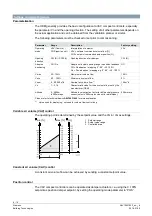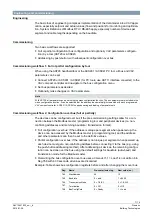
7 / 14
A6V10631832_en--_b
Siemens
2016-01-29
Building Technologies
Engineering and commissioning
Engineering
The basic task of engineering comprises implementation of the data model into a VAV appli-
cation, especially setpoint and actual values (flow and position) for monitoring and optimiza-
tion. System limitations of Modbus RTU / RS-485 apply, especially number of devices per
segment and cable lengths depending on the baudrate.
Commissioning
Two basic workflows are supported:
Full or partial configuration (bus configuration and optionally VAV parameters configura-
tion) by a tool (AST20 or ACS941)
Addressing by push-button, with subsequent configuration over bus
Commissioning workflow 1: Full or partial configuration by tool
When using the AST20 handheld tool or the ACS931 / ACS941 PC tool, all bus and VAV
parameters can be set.
Connect AST20 or ACS931 / ACS941 (for PC tools, use AST11 interface converter) to the
VAV compact controller and navigate to the bus configuration menu
Set bus parameters as desired
Optionally make changes on VAV parameters.
Note
With AST20, all parameters can be set using the mass configuration function. The bus parameters are included in the
mass configuration function. It can be selected that the address is automatically incremented with each programmed
VAV compact controller. ACS931 / ACS941 supports saving and loading of parameter sets.
Commissioning workflow 2: Configuration over bus (full or partially)
The devices can be configured over bus if the pre-commissioning settings allow for a con-
nection between the Modbus master / programming tool and peripheral devices (i.e. non-
conflicting addresses and matching baudrate / transmission format).
Full configuration over bus: If the address is unique per segment when powered up, the
device can be accessed by the Modbus master (or programming tool) and the address
and other parameters can then be set to the definitive values.
Partial configuration over bus: If the address is not unique per segment when powered up,
each device must get a non-conflicting address before connecting it to the bus (e.g. using
the push-button addressing method). After addressing all devices, the remaining configu-
ration can be done over the bus using the default settings for baudrate (auto-baud) and
transmission mode for the Modbus master.
Overwriting the bus configuration over bus uses a timeout. If „1 = Load“ is not written into
Reg 768 within 30 seconds, all values are discarded.
Example: Table shows bus configuration registers before and after changing them over bus.
Reg.
Name
Pre-commissioning
New value (ex.)
764
MacAddress
46
12
765
Baudrate
0 = auto
1 = 9600
766
Transmission Mode
0 = 1-8-E-1
3 = 1-8-N-2
767
Termination
0 = Off
0 = Off
768
BusConfigCmd
0 = Ready
1 = Load
































